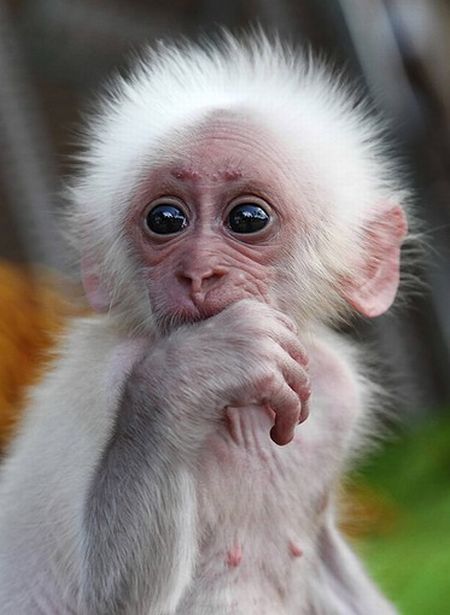Source(google.com.pk)
Though often called the koala "bear," this cuddly animal is not a bear at all; it is a marsupial, or pouched mammal. After giving birth, a female koala carries her baby in her pouch for about six months. When the infant emerges, it rides on its mother's back or clings to her belly, accompanying her everywhere until it is about a year old.
Koalas live in eastern Australia, where the eucalyptus trees they love are most plentiful. In fact, they rarely leave these trees, and their sharp claws and opposable digits easily keep them aloft. During the day they doze, tucked into forks or nooks in the trees, sleeping for up to 18 hours.
When not asleep a koala feeds on eucalyptus leaves, especially at night. Koalas do not drink much water and they get most of their moisture from these leaves. Each animal eats a tremendous amount for its size—about two and a half pounds (one kilogram) of leaves a day. Koalas even store snacks of leaves in pouches in their cheeks.
A special digestive system—a long gut—allows koalas to break down the tough eucalyptus leaves and remain unharmed by their poison. Koalas eat so many of these leaves that they take on a distinctive odor from their oil, reminiscent of cough drops.
These plump, fuzzy mammals were widely hunted during the 1920s and 1930s, and their populations plunged. Helped by reintroduction, they have reappeared over much of their former range, but their populations are smaller and scattered. Koalas need a lot of space—about a hundred trees per animal—a pressing problem as Australia's woodlands continue to shrink.
The cheetah is the world's fastest land mammal. With acceleration that would leave most automobiles in the dust, a cheetah can go from 0 to 60 miles (96 kilometers) an hour in only three seconds. These big cats are quite nimble at high speed and can make quick and sudden turns in pursuit of prey.
Before unleashing their speed, cheetahs use exceptionally keen eyesight to scan their grassland environment for signs of prey—especially antelope and hares. This big cat is a daylight hunter that benefits from stealthy movement and a distinctive spotted coat that allows it to blend easily into high, dry grasses.
When the moment is right a cheetah will sprint after its quarry and attempt to knock it down. Such chases cost the hunter a tremendous amount of energy and are usually over in less than a minute. If successful, the cheetah will often drag its kill to a shady hiding place to protect it from opportunistic animals that sometimes steal a kill before the cheetah can eat. Cheetahs need only drink once every three to four days.
Female cheetahs typically have a litter of three cubs and live with them for one and a half to two years. Young cubs spend their first year learning from their mother and practicing hunting techniques with playful games. Male cheetahs live alone or in small groups, often with their littermates.
Most wild cheetahs are found in eastern and southwestern Africa. Perhaps only 7,000 to 10,000 of these big cats remain, and those are under pressure as the wide-open grasslands they favor are disappearing at the hands of human settlers.
Tigers don't normally snuggle with orangutans. The big cats are meat-eaters, after all. But when Demis and Manis the tiger cubs were rejected by their mother, zookeepers at Taman Safari Zoo thought they might like the company of two other orphan siblings: Nia and Irma the orangutans.
"The first time I put them together, they just played," says zookeeper Sri Suwarni. The four shared toys, wrestled, and took naps together. Then one morning, Nia and Irma began hugging Demis the tiger, and he lick-kissed them back! "That's when I knew they were true friends," Suwarni says.
As the tigers grew, their natural instincts started showing, so Suwarni moved them into a separate exhibit. Now two other apes Suwarni is raising have also made a new friend—a leopard cub.
Baby Animals Pictures Baby Animals Pictures Wallpaper With Their Mothers Names Clipart Coloring Pages Cute Cartoon Photos

Baby Animals Pictures Baby Animals Pictures Wallpaper With Their Mothers Names Clipart Coloring Pages Cute Cartoon Photos

Baby Animals Pictures Baby Animals Pictures Wallpaper With Their Mothers Names Clipart Coloring Pages Cute Cartoon Photos

Baby Animals Pictures Baby Animals Pictures Wallpaper With Their Mothers Names Clipart Coloring Pages Cute Cartoon Photos
.jpg)
Baby Animals Pictures Baby Animals Pictures Wallpaper With Their Mothers Names Clipart Coloring Pages Cute Cartoon Photos

Baby Animals Pictures Baby Animals Pictures Wallpaper With Their Mothers Names Clipart Coloring Pages Cute Cartoon Photos

Baby Animals Pictures Baby Animals Pictures Wallpaper With Their Mothers Names Clipart Coloring Pages Cute Cartoon Photos

Baby Animals Pictures Baby Animals Pictures Wallpaper With Their Mothers Names Clipart Coloring Pages Cute Cartoon Photos
Baby Animals Pictures Baby Animals Pictures Wallpaper With Their Mothers Names Clipart Coloring Pages Cute Cartoon Photos

Baby Animals Pictures Baby Animals Pictures Wallpaper With Their Mothers Names Clipart Coloring Pages Cute Cartoon Photos

Baby Animals Pictures Baby Animals Pictures Wallpaper With Their Mothers Names Clipart Coloring Pages Cute Cartoon Photos

Baby Animals Pictures Baby Animals Pictures Wallpaper With Their Mothers Names Clipart Coloring Pages Cute Cartoon Photos

Baby Animals Pictures Baby Animals Pictures Wallpaper With Their Mothers Names Clipart Coloring Pages Cute Cartoon Photos

Baby Animals Pictures Baby Animals Pictures Wallpaper With Their Mothers Names Clipart Coloring Pages Cute Cartoon Photos

Baby Animals Pictures Baby Animals Pictures Wallpaper With Their Mothers Names Clipart Coloring Pages Cute Cartoon Photos
No comments:
Post a Comment